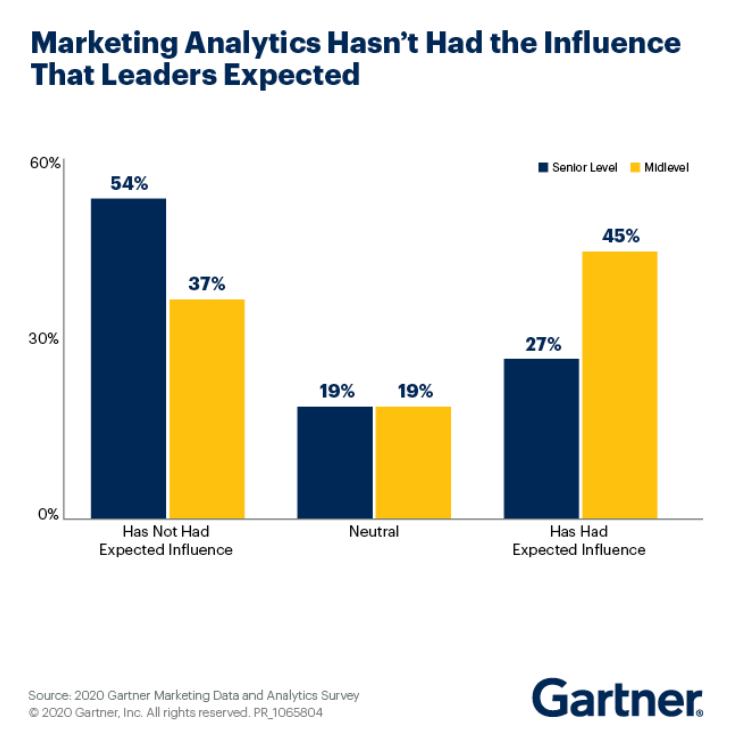How to Choose a Model for Effective Travel Attribution

Given the current challenges that travel marketers are facing right now, ensuring that you have the right attribution model in place is a top priority.
Despite this, QueryClick’s research shows that 90% of those responsible for optimising marketing revenue and ROI simply aren’t able to access the type of model needed to accurately attribute the impact of their marketing activities.
Gartner surveyed over 400 marketing leaders and analytics practitioners to better understand the current approaches to marketing analytics that support marketing strategies to enable future growth and success.
And the impact of this is echoed in Gartner data showing that 54% of executives think that marketing analytics hasn’t had the influence they expected on their business.

Problems with existing attribution models
At the heart of the issue are limitations in existing attribution models that simply aren’t set up to handle the depth, and complexity, of customer buying journeys for travel services.
To help illustrate the point, let’s consider a hypothetical travel customer journey and assess how some of the more common attribution models view and attribute activity against it.
Rules-based attribution is just too simplistic
Take the example below, where someone is looking to research and book holiday which has a relatively long buying journey:
- A traveller decides to book themselves a holiday and does an initial Google search for destinations on their mobile.
- Based on the search they find a great article on your blog about holidays in Corfu and quickly check some initial options on your website before leaving without booking.
- They spend some time over the next week or so drifting around other sites looking at other providers on a combination of mobile and tablet – and click through a Facebook advert for the same holiday in Corfu on your website but again don’t book.
- A week later they sit down at their desktop to do some final checks and perform a Google search for the Corfu holiday and your brand name – clicking through on a paid search ad to book the holiday.
In reality, this is likely to be even more complex with more steps and even more nuance (for example research by Tripadvisor indicates that travellers browse an average of 38 websites before making a more complicated travel purchase). But it helps guide us for now.
So, how do some of the simpler attribution models attribute conversion value in this scenario?
Last click approach
In last click attribution – which is the method still used by many travel marketers – 100% of the credit would be allocated to the paid search advert. Which is the final touchpoint prior to booking.

At the same time all of the other touchpoints – across search, blog, Facebook ad etc – receive 0% credit. Which is clearly not reflective of the real-life, nuanced customer journey and impact points. And which skews attribution markedly going forward.
While Last click may deliver limited value in niche scenarios – for example, where your focus is lower funnel conversions alone – it is not capable of effectively analysing sophisticated, multi-touch travel purchase journeys.
First-click approach
This approach suffers from the same, over-simplified approach above but effectively in reverse.

Just as Last-click creates an attribution bias at the end of the customer journey, First-click applies this on the front end.
In our scenario above, First-click applies 100% credit conversion to the blog article. Which it deems to be the first, and only, crucial determinant in the purchase decision. Again, a gross over-simplification from an attribution perspective.
In addition to these single-click models, there are also a range of multi-touch rules-based models to choose from including:
- Linear attribution
- U-shaped
- Time decay
- W-shaped
- Custom models
Each of the above attempts to improve on Single-click analysis by spreading attribution across multiple touchpoints, allocating varying degrees of credit. However, they have a ‘channel only’ attribution focus and also suffer data quality issues which renders up to 80% of the data they use incorrect.
Is poor quality data hurting your attribution? Find out here…
Data-driven and probabilistic approaches add sophistication
Limitations and concerns about the effectiveness of rules-based models have meant travel marketers are also exploring more sophisticated attribution approaches including:
Statistical or data driven attribution
These models apply channel attribution that is predicated by a weighting based approach using the data that is available to them. Some of the most commonly used packages offer this functionality to travel marketers – for example, even the free version of Google Analytics.
However, the use of vendor specific tags and lack of connection to data collected elsewhere create very real limitations for these models. And they are also prone to the same data quality issues as the rules-based options discussed earlier.
Media mix modelling (MMM)
MMMs use mathematical techniques to establish incrementality in large data sets and can integrate data from offline media activity.

For example, the business on the right wanted to understand the incremental impact of using an offline catalogue. By using MMM techniques – based on data analysis of media channel mix, customer cohorts, use of the catalogue and acquisition outcomes – they were able to identify a 2% incremental benefit from running offline catalogues with an email campaign.
The sheer complexity and volume of data needed to support MMM on an-ongoing basis make it an expensive attribution proposition. Although it can be used to answer specific time-bound marketing attribution questions.
Probabilistic modelling
Advances in Machine Learning technology combined with probabilistic modelling techniques like Shapley and Markov chain mean it is also now possible to find an average incremental attribution value for touchpoints on all conversion paths that exist in a marketing customer journey.

In this example, Corvidae was able to assess and more accurately attribute revenue contribution by channel for a well-known client. As you can see, compared to Last-Click Non Direct attribution (the rules model used by GA 360 and Adobe by default) channel attribution has changed by £39.9m.
Given total turnover is only £136.7m across the measured channels, this radically altered the ROI implications of media spend. Particularly in Paid Search and PLA (Paid Search Shopping Ads) for the client who were able to quickly re-allocate spend for a much improved ROI.
Despite providing improvements on the simplistic, rules-based models covered earlier they also have their limitations including the fact that:
- they need to be re-modelled to provide more granular outcomes than just channel attribution
- they don’t work for smaller data sets
- they are not able to deliver on the elusive goal of understanding engagement and probability to convert – at an individual level
Which is where campaign – or visit – level attribution comes in.
The emergence of campaign level attribution
Campaign (or Visit) level attribution blends Machine Learning and bleeding edge data science (including AI) with many of the techniques above to fix the incoming data being generated by analytics platforms – including Google Analytics. And joining data to any channel online or off.
This creates a scored value against each and every marketing touchpoint that the individual has engaged with, in order to produce a fully attributed map of the customer journey – which travel marketers can use to assess all travel marketing activity.
And the results are hugely powerful.

The graph above shows how Corvidae – our own attribution platform which uses campaign level attribution – was used to rebuild Facebook channel data and identify saturated spend including identifying:
- that Facebook ad spend was in fact driving 68% less revenue than Facebook was reporting
- that redeploying 30% of spend from this campaign could generate an additional £14k revenue per month
It’s clear that travel marketers have challenges in getting their hands on the type of attribution models they need to be effective.
And limitations in rudimentary rules-based models like Last-click and First-click – and various extensions of the rules based approach – mean that they aren’t appropriate for the increasingly longer and more complex user journeys associated with travel purchases.
However, advances in Machine Learning and AI are making attribution right across the customer journey a reality and providing the type of visit level attribution that travel marketers need to impact ROI.
Need help with selecting the right attribution solution for your needs?
Download a copy of our Buyers Guide to Selecting the Right Attribution Solution which dispels some of the common misconceptions about attribution technology and provides some guiding thoughts to factor into your decision-making process.




